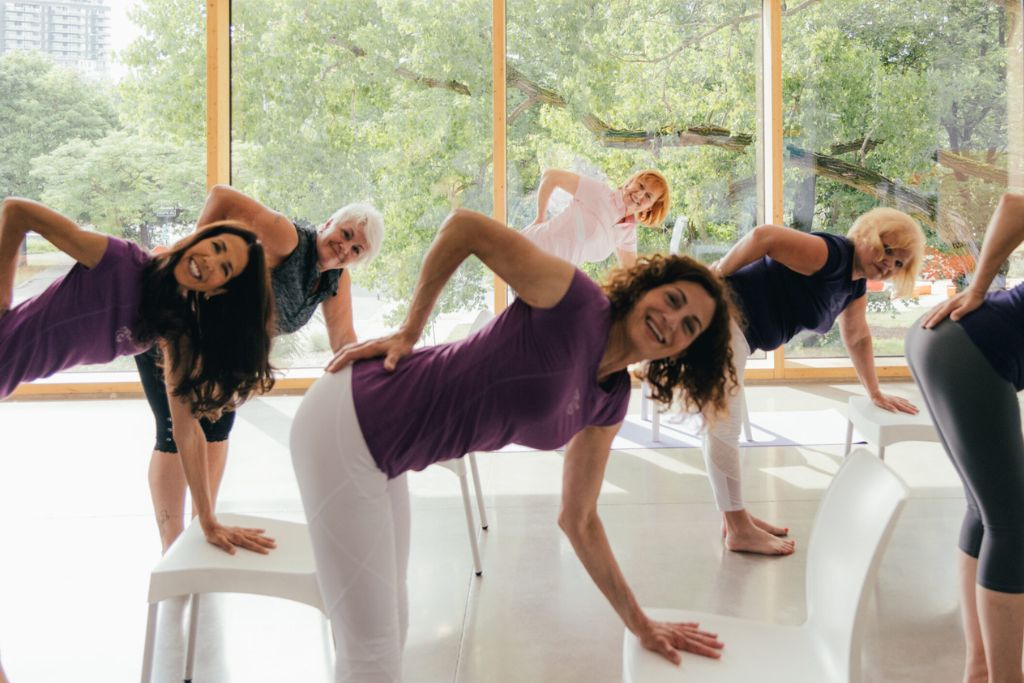Practicing yoga can significantly improve flexibility through a combination of physiological and neurological adaptations. Regularly engaging in yoga poses targets muscles, tendons, ligaments, and connective tissues which enhance flexibility. The repeated stretching of muscles during yoga practice gradually increases muscle length and flexibility. Stretching also stimulates the production of collagen, a protein that enhances elasticity and pliability of tissues, tendons, and ligaments to stretch further over time.
Yoga encourages an increased blood flow to the muscles and surrounding tissues during practice. The improved circulation supplies essential nutrients and oxygen to the muscles, aiding the recovery and repair process. It also helps to remove waste products and toxins, reducing muscle stiffness and soreness after stretching.
From “prop-less” origins to chair yoga’s modern evolution
Traditional yoga was not practiced using a prop. The use of a chair as a yoga prop has a modern history. The influential yoga teacher B.K.S. Iyengar is widely recognised for his influence on the use of props in yoga classes today. In Iyengar Yoga, the chair is often used to help students perform yoga poses allowing them accessibility to greater flexibility.
What is chair yoga good for?
The chair can be used in various ways to modify poses, improve alignment, and offer a sense of security, making yoga more accessible to a broader audience. The chair allows practitioners to experience the benefits of different yoga poses without putting excessive strain on their bodies. Using a chair prop can take your class to the next level as way to practice inverted poses. For example, practicing a supported headstand using a chair allows you to gradually build strength and confidence.
Today, the use of chairs in yoga has expanded beyond Iyengar Yoga into various yoga styles and practices. The chair can be a valuable asset for both the beginner and experienced practitioners to deepen their practice, improve flexibility. Also, those who have limitations due to injuries or other physical conditions benefit from using the chair to modify poses and hold the postures longer and with greater ease. For individuals who may find it challenging to get up and down from the floor, a chair allows them to experience the benefits of yoga while remaining seated, thus expanding their practice options.
Progression and mastery in chair-assisted poses
Regardless of experience or fitness level, following are some reasons why you might want to consider using a chair prop in your yoga class:
Utilising a chair as a prop will assist in increasing flexibility by allowing you to access deeper stretches and work on specific areas that might be more challenging. Chairs help you to fine-tune alignment and understand your body’s optimal position in the posture. In addition to helping build stability and balance, incorporating a chair into your practice will challenge and help you develop your core strength.
Certain yoga poses practiced with the chair can engage muscles that might not commonly be targeted in other sports or physical fitness programs. This can lead to improved muscle balance, which is essential for overall performance and injury prevention.
While practicing yoga stretches and postures with a chair, you can direct more attention to the breath and subtleties of the postures to encourage a deeper personal connection and a heightened sense of mindfulness.
Following are some examples of how the chair allows for adaptations of the poses to improve flexibility:
Seated Forward Bend (Paschimottanasana) is adapted to be practiced while sitting on the chair with legs extended forward. The chair assists in maintaining without straining.
Seated Wide-Legged Forward Bend (Upavistha Konasana) is a similar posture except the legs. In this posture the support of the chair will help practice relaxing to promote inner thigh and hip flexibility.
Another pose that can be adapted to a chair is the Seated Pigeon Pose where one ankle is crossed over the opposite knee while sitting on a chair to target the stretching of the hip and glutes.
The chair also provides excellent support in twisting postures such as Seated Twist (Ardha Matsyendrasana) or Standing Forward Bend (Uttanasana), the chair may be used to support the hands, allowing the spine to elongate more comfortably.
Chair yoga’s impact on the nervous system
Over time, the nervous system becomes more accustomed to the extended range of motion experienced during yoga practice. This leads to a reduction in the stretch reflex, a protective mechanism that resists overstretching of the muscles. As the stretch reflex diminishes, the body becomes more comfortable and willing to explore deeper stretches, increasing overall flexibility. The chair prop plays a key role in supporting your yoga program no matter what your level.
Embracing individuality and celebrating progress
Remember that flexibility varies from person to person, and everyone’s body is different. Focus on your own progress and avoid comparing yourself to others. Celebrate each milestone along your flexibility journey and enjoy the process of exploring and deepening your practice while using a chair! Beautiful discoveries await!

